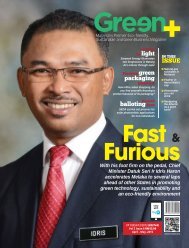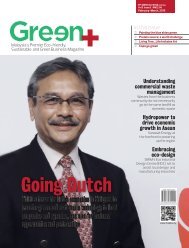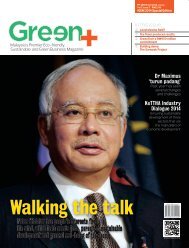Green+ Malaysia's Premier Eco-friendly, Sustainable and Green Business Magazine
SIRIM - Technology Provider
SIRIM - Technology Provider
You also want an ePaper? Increase the reach of your titles
YUMPU automatically turns print PDFs into web optimized ePapers that Google loves.
COLUMN<br />
Regenerative design,<br />
the next conversation of<br />
<strong>Green</strong>-built environment<br />
Why going ‘<strong>Green</strong>’ is merely the opening chapter towards<br />
the better built environment we need to be in<br />
A<br />
reality check indeed.<br />
Recently I gave a talk in<br />
the World Diabetes Day<br />
(14/11/14) awareness<br />
exhibition which was held<br />
at KLCC Esplanade, in partnership with<br />
Novo Nordisk, a pharmaceutical company<br />
which manufactures one fifth of<br />
the world’s insulin supply. So you may<br />
be thinking, what does a green building<br />
consultant have to do with World<br />
Diabetes Day? Winston Churchill<br />
once quoted “We shape our buildings,<br />
<strong>and</strong> afterwards our buildings shape<br />
us”. The evidence of us unveiling the<br />
p<strong>and</strong>ora’s box of urban planning is<br />
irrefutably obvious, from the increasing<br />
occurrence of flash flood around<br />
the greater Klang Valley, to being a<br />
nation rated as the highest among<br />
Asian countries for obesity. It nonsensical<br />
to place an escalator serving a<br />
gym, neither designing a wide spread<br />
horizontal city that requires ever stationary<br />
human beings sitting in their<br />
carbon releasing machines crawling<br />
across the miles when they could just<br />
walk actively in a multi usage medium<br />
density vertical city.<br />
Cities are the physical testimonies<br />
of any civilization success, be it the<br />
famous historical l<strong>and</strong>marks, ever<br />
increasing modern skyscraper, efficient<br />
public transportation system<br />
or the public squares <strong>and</strong> parks.<br />
Nevertheless, it is a fact that our built<br />
environment revolves closely with<br />
the driving force of economics today,<br />
which has subsequently caused many<br />
externalities which are not accounted<br />
for. One of it is public health impact<br />
<strong>and</strong> community well-being which I<br />
had elaborated during the talk then.<br />
It is exciting to see the progressive<br />
growth of green building wave which<br />
is participated by various authorities<br />
<strong>and</strong> property markets ever since<br />
<strong>Green</strong> Building Index was introduced<br />
in 2009. To date, GBI has charted 100<br />
million square feet of green buildings<br />
certified <strong>and</strong> many related built environment<br />
stakeholders are proposing<br />
various alternative green building<br />
rating tools.<br />
Gene-Harn<br />
currently<br />
works as<br />
a <strong>Green</strong><br />
Building<br />
Consultant<br />
at IEN<br />
Consultants<br />
based in<br />
Bangsar. The<br />
architecture<br />
masters<br />
student is<br />
passionate<br />
towards the<br />
potential<br />
benefits of<br />
sustainable<br />
urban design<br />
<strong>and</strong> green<br />
buildings<br />
towards<br />
the aspect<br />
of social,<br />
environment<br />
<strong>and</strong> economy<br />
for a better<br />
world.<br />
Redefining Sustainability<br />
through Sufficiency Themed<br />
Design Process<br />
However, one needs to be cautiously<br />
optimistic because even with the<br />
entire city <strong>and</strong> all buildings certified as<br />
‘green’, that is merely solving the tip of<br />
the iceberg of our built environment<br />
complexity issues. Sustainability is a<br />
noble ambition, but one I believe is short<br />
sighted <strong>and</strong> increasingly meaningless<br />
in today’s developing world. Even, the<br />
word “<strong>Sustainable</strong> Development” is<br />
probably the most oxymoron term ever<br />
existed. Simply due to the fact that it is<br />
not possible for an infinite growth on a<br />
finite planet, this is also even if you have<br />
a very low carbon or ecological footprint<br />
per capita, but with a projection of 10 billion<br />
population by 2030.<br />
If one is to evaluate the true sustainability<br />
of our built environment, one<br />
has to look at regenerative design, the<br />
process oriented systems theory based<br />
approach to design, or, to design the<br />
way of our city. Communities should<br />
restore natural capital <strong>and</strong> produce<br />
Insight By Gene-Harn<br />
positive externalities, in contrast to the<br />
current, much economic development<br />
centric building industry progress<br />
which means little for mankind progress.<br />
Regenerative design develops a<br />
mutually enhancing relationship with<br />
the earth. It augments the capacity<br />
of existing resources <strong>and</strong> systems,<br />
rather than depleting or simply maintaining<br />
them. If we measure our built<br />
environment performance against the<br />
following 6 aspects <strong>and</strong> 3 fundamental<br />
principles, it is clear that our current<br />
state of green building wave progress<br />
is incommensurate to the rate of<br />
deterioration of our built environment<br />
in respect to the holistic principles of<br />
regenerative design.<br />
FOOD AND SOIL<br />
Soil is Gold. Soil is a non-renewable<br />
resource that is often taken for granted.<br />
While the green revolution in agriculture<br />
is credited with allowing relatively<br />
few farmers to feed over 7 billion people<br />
across the world, it has been extremely<br />
damaging to the natural health <strong>and</strong><br />
productivity of the soil as well as the<br />
social fabric of rural communities.<br />
There is a finite amount of arable l<strong>and</strong><br />
in Malaysia alone which is only 8% of<br />
total area space, <strong>and</strong> we need to use<br />
l<strong>and</strong> judiciously <strong>and</strong> according to its<br />
capabilities <strong>and</strong> assets. The factuality<br />
of nature cannot be our total morality,<br />
but by being ignorant of nature we are<br />
ignorant of our limits as well as our possibilities.<br />
Most of us simply do not know<br />
the origins of the food on our plates<br />
<strong>and</strong> also where does the 930 tonnes of<br />
Malaysia food waste go to daily.<br />
There is an urgent need to decentralize<br />
<strong>and</strong> relocalize growth, variety,<br />
distribution <strong>and</strong> waste h<strong>and</strong>ling of food,<br />
to replenish <strong>and</strong> rejuvenate the soil by<br />
closing the nutrient loop, to encourage<br />
urban permaculture trend to be commercially<br />
recognized. The crucial fact is<br />
that by decentralizing <strong>and</strong> encouraging<br />
community sufficient food system,<br />
there will be food security through<br />
localized food sovereignty. Both<br />
30<br />
november-december, green+.2014





